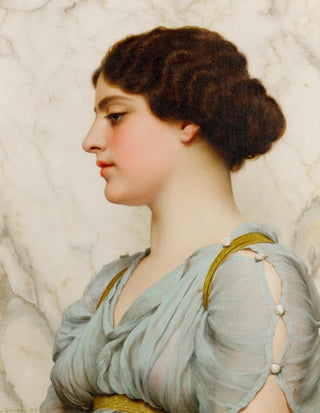Art print | A Roman beauty - John William Godward


View from behind

Frame (optional)
John William Godward's "A Roman Beauty" is a true ode to classical beauty, where every detail seems to whisper echoes of a bygone era. Gazing at this piece, the viewer is immediately transported into a world of refinement and elegance, where art and nature intertwine harmoniously. Godward, a British painter of the late 19th century, is part of the neo-classical movement, but his unique vision and impeccable technique give him a distinctive place in art history. This artwork, with its soothing atmosphere and delicate colors, invites complete immersion into a universe where time appears to stand still.
Style and uniqueness of the artwork
The aesthetic of "A Roman Beauty" is characterized by a soft, luminous color palette that evokes the warmth of the Mediterranean sun. The flowing drapery of the female figure's clothing, as well as the precision of floral and architectural details, demonstrate a concern for realism and impressive technical mastery. Godward manages to capture not only the physical beauty of his model but also a certain inner serenity, suggesting a deep connection with her environment. Every element of the composition, from ornaments to textures, is carefully arranged to create a visual harmony that delights the eye. This artwork stands out for its ability to transcend a simple portrait to become a true celebration of timeless beauty.
The artist and his influence
John William Godward, often considered one of the last representatives of the Pre-Raphaelite movement, established himself through his distinctive style and passion for antiquity. Trained at the Royal Academy, he was influenced by masters such as Sir Lawrence Alma-Tadema and Edward Burne-Jones, but developed a personal approach that is uniquely his own. His fascination with mythology and Roman culture is reflected in many works, where he explores themes of beauty, sensuality, and escapism. Despite a career marked by successes, Godward also experienced moments of disillusionment with the evolution of modern art, which led him to gradually withdraw from the art scene. Nevertheless, his

Matte finish

View from behind

Frame (optional)
John William Godward's "A Roman Beauty" is a true ode to classical beauty, where every detail seems to whisper echoes of a bygone era. Gazing at this piece, the viewer is immediately transported into a world of refinement and elegance, where art and nature intertwine harmoniously. Godward, a British painter of the late 19th century, is part of the neo-classical movement, but his unique vision and impeccable technique give him a distinctive place in art history. This artwork, with its soothing atmosphere and delicate colors, invites complete immersion into a universe where time appears to stand still.
Style and uniqueness of the artwork
The aesthetic of "A Roman Beauty" is characterized by a soft, luminous color palette that evokes the warmth of the Mediterranean sun. The flowing drapery of the female figure's clothing, as well as the precision of floral and architectural details, demonstrate a concern for realism and impressive technical mastery. Godward manages to capture not only the physical beauty of his model but also a certain inner serenity, suggesting a deep connection with her environment. Every element of the composition, from ornaments to textures, is carefully arranged to create a visual harmony that delights the eye. This artwork stands out for its ability to transcend a simple portrait to become a true celebration of timeless beauty.
The artist and his influence
John William Godward, often considered one of the last representatives of the Pre-Raphaelite movement, established himself through his distinctive style and passion for antiquity. Trained at the Royal Academy, he was influenced by masters such as Sir Lawrence Alma-Tadema and Edward Burne-Jones, but developed a personal approach that is uniquely his own. His fascination with mythology and Roman culture is reflected in many works, where he explores themes of beauty, sensuality, and escapism. Despite a career marked by successes, Godward also experienced moments of disillusionment with the evolution of modern art, which led him to gradually withdraw from the art scene. Nevertheless, his






